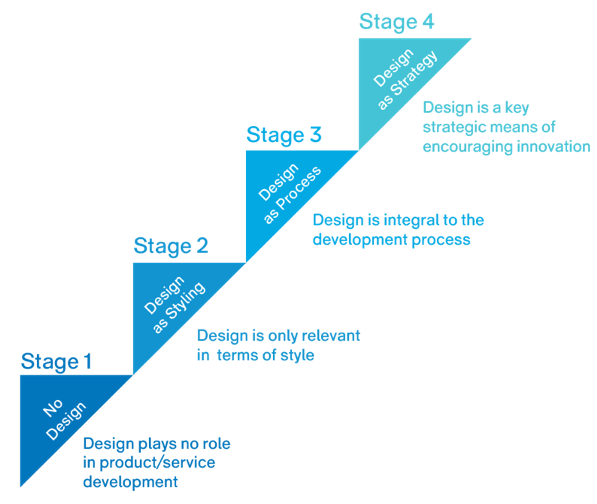Design and business, which seem to be completely different from each other, turn out to be firmly related.
As a person coming from business background, the Master degree in Business Design Management completely changed my mindset and value toward business and design. Before taking the program, I even thought that they would teach us something related to graphical or fashion design (?!) since design has been very popular in terms of aesthetic. However, during one year of the program with full of hands-on workshops, lectures and projects, I think of design differently, as not only the look and view but also as an efficient strategy and thinking toward customer to enhance business growth.
In 2013-2014, we teamed up five people to establish a research within a sample of 100 Finnish companies (corporates, SMEs and start-ups) to understand what they respond toward design. The parameter of this qualitative research is based on the design ladder introduced by the Design Council (figure 1). In this graph, design is categorised into four modules from the bottom to the top: no design, design as styling, design as process and design as strategy. We would like to see what Finnish companies think about design, and how they apply design into their business operation.

The Design Ladder
Surprisingly, the result showed that more than 70% of the Finnish companies think of design as style and look (design at the bottom of the ladder), and they found it challenging to explain how they utilized design in their daily activity. Hence, design was of little comprehended and used back then, five years ago. We also found that corporates already started to invest to acquire design experts in their business operations, and start-ups were adopting design in their early business model and product development. However, SMEs were behind in this process: they were in a dilemma to renew themselves as well as found it challenging to invest in a totally new thing as such.
So, that was the situation five years ago. Today, what has happened? I wish I could team up again to do a second round of the research to see how the relation between design and business has changed, in half of a decade. However, just by observing, I made these findings: The amount of design agencies in Helsinki is blooming, and more design jobs are on recruitment boards. More companies are acquiring design experts in different ways: adopting a designer in a team, hiring design agency in certain business activities, having a designer to participate in business meetings and workshops, sending staff to learn about design thinking in business, etc. Furthermore, design has risen in several discussions in business forums, business talks, venture conferences, etc. As well, design has been emphasized in startup development process, and design is a gigantic topic at which several large corporates in Finland are looking.
My friend who is working at Kone design team (her background being in business) shared with me how big their team has grown in 4 years, after she joined it. In Kone alone and in many other corporates, design teams are formed and are playing more important role in business operations. They participate in building up business vision and strategy. If we look back at the design ladder, it is a sign of that design has climbed quite a big step toward the top of the ladder in many contexts already. This is good news for Finland.
PhD Student
Reference
McNabola, Introducing Design for Europe, Design Council. Retreived 20.5.2018 https://www.designcouncil.org.uk/news-opinion/introducing-design-europe
